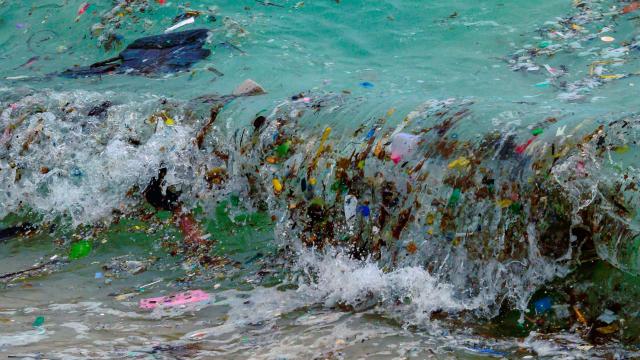The world dumps some 8 billion kilograms of plastic into the ocean every year — and now, you can check out how all that trash moves around. NASA released an animation showing shifting plastic concentrations in the world’s oceans over an 18-month period, the first research of its kind to map plastics on such a global scale for such a long time.
Once plastic gets into the ocean, it doesn’t just float around uniformly. (That’s part of what makes cleanup so difficult.) A lot of plastic gathers in concentrations in the North Atlantic and North Pacific garbage gyres — commonly referred to as garbage patches. These places are relatively easy to measure plastic concentrations, which are performed by dragging a plankton net behind a boat. But these garbage gyres aren’t representative of plastic concentrations in much of the rest of the world’s oceans, and the manual net-based technique to measure plastic isn’t exactly realistic for taking concentrations in the rest of the world.
The NASA animation and images are based on a new method of tracking and mapping plastics’ journey through the worlds’ oceans, developed by researchers at the University of Michigan. The technique uses measurements of how rough the ocean surface is taken with eight microsatellites, which allows scientists to calculate wind speeds in the ocean. Normally a very useful tool for measuring hurricanes and monitoring weather, it turns out that these wind measurements also can help measure plastic. When plastic is close to the surface of the ocean, waters tend to be calmer with fewer waves.
“In cleaner waters, there’s a high degree of agreement between ocean roughness and wind speed,” Chris Ruf, one of the authors of the research, told NASA Earth Observatory. “But as you head into the Great Pacific Garbage Patch, you see a bigger discrepancy between wind speed measurements and the roughness of the surface.”
To figure out where calmer spots in the ocean might be associated with the presence of plastic, University of Michigan researchers cross-referenced the space radar measurements of surface roughness with wind speed measurements from other sources on the ground (or seas, as the case may be) to spot places in the ocean where waters were calmer but wind speeds might still have been strong — suggesting the presence of plastic. They then compared those with other models of ocean plastics, looking at locations between 38 degrees north and south of the equator. (Hence the sharp cutoff line in the animation above.)
The researchers monitored these various data sources around the world for almost a year and a half, between April 2017 all the way through September 2018, making them the first to monitor ocean plastics over such a big scale and long time period. That allowed them to notice some interesting changes, including how garbage concentrations in the Great Pacific Garbage Patch are higher in the summer and lower in the winter. That’s possibly due to how the colder water encourages vertical mixing, which could cause trash to travel to deeper levels of the water.
This tool can be incredibly helpful to understanding how the trash that’s in the ocean moves around, which can help us figure out the best and most efficient ways to clean up beaches or stop plastic from reaching the ocean in the first place. We already know that the vast, vast majority of plastic pollution enters the world’s oceans exclusively via rivers and streams, making river cleanups a tantalising opportunity to make inroads. But the scale of the amount of plastic in the ocean is so large that many experts say there’s no hope of actually cleaning all of it up, despite high-profile, well-funded projects claiming otherwise. Instead, advocacy efforts must switch to stopping the production of plastics in the first place. That could make the NASA animations of the future look less chaotic, which would be a good thing.
